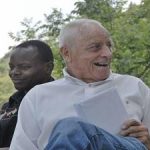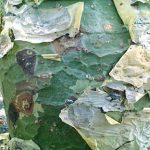TREE LIFE
December 2012
MASHONALAND CALENDAR
December 9th: Christmas Social at Mukuvisi Woodlands, from 9.30am. Details sent by email.
December 22nd (4th Saturday): No outing.
TREE OF THE MONTH
The Story of Ficus pollination
The fruit of the genus Ficus is unique and is derived from a hollow peduncle that becomes fleshy and forms a fruit called a syconium. The unfertilised ovaries provide the resin-like flavour associated with the fruit of a fig. Fruit can contain a closed or an open ostiole, or eye, located at the fruit apex.
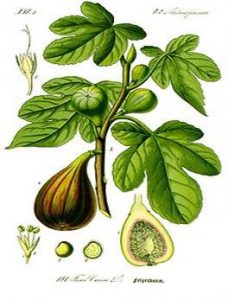
Illustration of Ficus carica
The Syconium is formed by an enlarged, fleshy, hollow receptacle with multiple ovaries on the inside surface. It is really a fleshy stem with a number of flowers, so it is considered both a multiple and an accessory fruit. The name comes from the ancient Greek word sykon meaning fig.
Evolution: The syconium is thought to have first evolved 83 million years ago in the Cretaceous period. As the bracts protecting the inflorescence tightened to form the ostiole, greatly increasing the pollinator specificity of the plant, this initiated a long and complex history of co-evolution between figs and their pollinating wasps. There are around 755 species of fig in the world, 113 of them in the Afrotropical region and 36 in the southern African region. Every species of fig has it’s own associated wasp species and conversely every wasp is associated with a specific Ficus species. This is known as obligate mutualism.
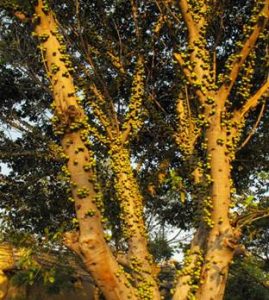
Ficus sansibarica
Morphology
The syconium is an urn-shaped receptacle which contains between 50 to 7000 highly simplified uniovulate flowers or florets (depending on the species) on its inner surface. It is closed to most organisms by the ostiole, formed by bracts. Syconia can be monoecious or functionally dioecious: the former contain female flowers with variable style length and few male flowers and produce seeds, wasps and pollen. Once pollinated the florets develop into achenes or drupes in which the seeds are enclosed by a layer of endocarp. From this perspective, the fig is an enclosure with tens to thousands of fruits within it.
Development: Formation of the syconium begins with the initial growth of bracts, which curve to form a receptacle. When the outer bracts meet, they form the ostiole by interlocking. Syconia may also develop lateral, basal or peduncular bracts. There is a relationship between the shape of the ostiole and the morphology of the wasps that pollinate the fig.
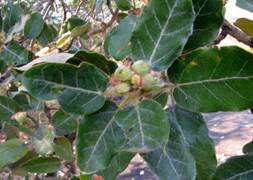
Ficus glumosa
Pollination: About half the Ficus species are monoecious, the other half being dioecious (males and females on different trees). Let us start with the monoecious life cycle. Here the male and female flowers are contained in the same fig but their reproductive cycles are several weeks apart. As the pollinating wasps’ lifespan is only a few days, pollen dispersal is continued by the next generation of wasps.
The tight ostiolar enclosure at the apex of the syconium makes the figs highly pollinator specific. When receptive to pollen, the ostiole slightly loosens, allowing the highly specialised wasps to enter through it. The wasps may lose their wings in the process and once inside they pollinate the female flowers. Some of the florets have styles longer than the ovipositor of the wasp and no egg is deposited in them, letting them develop as normal fruits. The wasps lay their eggs in the florets with shorter styles, which then form galls. The wasps die and the larvae develop in the galls, while seeds develop in the pollinated flowers. Four to six weeks after egg laying the wingless male wasps emerge, mate with the females still in their galls and cut a tunnel out of the syconium. As the females subsequently emerge they collect pollen on their bodies from the male flowers which have ripened later. After the wasps have emerged, chemical changes take place in the receptacle and it develops into a fruit.
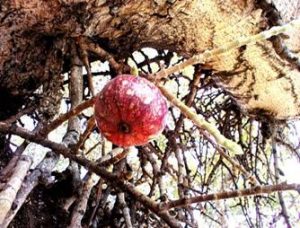
Ficus?
In dioecious figs the male and female fruits are borne on different trees. The male flowers all have a short style which allows the wasp to lay eggs in every floret. These produce wasps that become loaded with pollen before leaving the fig in which they have bred. The young wasps go in search of suitable fruits but they cannot differentiate between male and female fruits. As they enter a female fruit they fertilise the florets with the pollen collected in the male fruit, but because the style of all the florets in the female fruits are too long for the ovipositor of the wasp, no eggs can be laid in them and the floret has its normal development into fruits.
Reference:
Wikipedia: https://en.wikipedia.org/wiki/Syconium
-JPFelu
Dr Tom Muller’s 80th Birthday Party, Harare Botanic Gardens, 21st October 2012
This month we conclude the speeches given at Dr. Tom Muller’s birthday lunch.
Philip Gilbert-Green
My association with Tom goes back to 1963, the year after he took the position of Curator of the Botanic Garden.
My late mother worked at the Herbarium from 1963 until just after Independence, working initially for Hiram Wild, Bob Drummond and Tom and then latterly for Tom and Bob. Because of this, I became fairly well acquainted with Tom.
Because the position of Curator required a Bachelor of Science qualification, Tom’s numerous Swiss and Kew qualifications being deemed inadequate, he set about initially writing four A level subjects, before enrolling for a science degree at the University College of Rhodesia.
One of the A level subjects he chose was Geology and the only place he could study this was at Churchill School where I was a pupil. As an aspiring track athlete at Churchill, I had nothing on Tom who was an exceptionally talented runner. He trained with Terry Sullivan (sub four minute miler) and others and was Rhodesian 440 yard Champion during the time that he participated. His amazing physical fitness is still with him today, despite joint replacement surgery.
Tom has been an amazing mentor to many amateur gardeners and landscapers, not least to me. My own garden in Belgravia was largely set out by him and is the home of numerous special trees that he has given me. One of my most prized specimens is a Burttdaveyi nyasica which is the same as the first group of trees identified by Tom on the walk this morning.
Raoul Du Toit – Tom gravely disturbed by gravity
Tom and I were involved in several ecological surveys relating to proposed hydro-electric schemes on the Zambezi. One of these exercises took us to Victoria Falls in about 1982, where an Airforce Alouette helicopter was provided to fly us through Batoka Gorge and to land periodically to enable us to check the vegetation and other features.
Tom had apparently not had much helicopter flying experience but seemed to enjoy the initial flight from the airport, over flat ground, as he sat on the rear bench of the doorless helicopter. When we got to the edge of Batoka Gorge I saw his white-knuckled hand clench on a handhold as the pilot let the helicopter fall to the bottom in a sudden descent that left our stomachs behind.
Thereafter we buzzed through the zig-zag gorges below the Falls, just above the turbulent river, with Tom staring at the habitats with his normal intent expression which could also be read as a grim one.
We landed near a drilling rig that was investigating the rock formations at the proposed dam site. Before the blades had stopped turning Tom shed his seat belt and leapt out, berating the pilot loudly for flying dangerously. The pilot still had his helmet on and didn’t hear much of Tom’s tirade, but eventually gathered that Tom thought he could have fallen out several times during the rollercoaster flight, and heard about Tom’s wife and children.
He assured Tom that you have to be pretty stupid to fall out of a helicopter and that his mode of flying maintained a centre of gravity that would reduce this risk. Tom stomped off to do his vegetation plot and came back in a much happier frame of mind having derived his typical enjoyment from the bush around him.
As we took off I saw to my horror that Tom had placed a large rock on the edge of the bench he was sitting on. The helicopter rotated over the gorge and the rock fell straight out, fortunately missing the tail rotor. Tom saw me looking at this test and gave me a big wink.
Having proven his point and having realised what an incredible platform the helicopter provided for his work, as opposed to sitting on the bonnet of a Land Rover in his black underpants, Tom thoroughly enjoyed the rest of the helicopter flying.
Mary Lovemore
It is a wonderful thing if you can see a tree from your window, for the mind is uplifted and enriched by living close to trees. You can be drawn to a certain tree in the same way that you can be conscious of affinity with a person. You can make a friend of a tree, for it is something more than wood and bark and sap. It is an expression of beauty, strength and grace, and it is built up by the same force that holds your own body together, the mysterious power of God at work in His creations.
We are gathered here because we have this love of trees in common and have just had a lovely walk with Tom in his garden – how much pleasure these gardens have given to us all.
Tom, I feel sure that somewhere in your youth or childhood in the beautiful countryside of Switzerland you must have done something good!! Your enthusiasm and dedication for the project for which you had travelled to Africa and this amazing patch of woodland set aside for the creation of a National Botanic Garden was evident from the very first time Desmond and I met you when you very first arrived. From that day on there evolved a relationship between you and this patch of glorious woodland. You once told us – as you must have told many others “which ever way you cast your eyes the vista must be something of beauty” – your vision has been able to create rain forests, savannahs, lowveld riverine, and all, from this already magnificent corner of the world.
Now, this did not just happen. Tom’s enthusiasm and energy rubbed off onto anyone who stopped to listen. He soon engaged those of us who were working in the field, and what a total pleasure it was taking Tom on reconnaissance and collecting trips. The bush took on a whole new meaning and it did not take Tom long to know exactly (and without the aid of a GPS) where everything was where he would be able to collect seed next year etc. He had us all engaged in his project and one of his most enthusiastic supporters was our beloved Joe Ritchken, physician, botanist and friend. Joe was busily involved in propagating seeds collected on these trips. Desmond diverted tsetse lorries to collect the right soil for the infant trees to grow in so they felt like they were at home. We would walk in the park amongst baby trees newly planted out and our Tom would point out exactly how it was going to be – and it was.
I feel exceedingly privileged to have been marginally involved in these gardens since before they were designated Botanic Gardens. Our then Director, J.K. Chorley, was involved with the city fathers at the time,1954/55, and did much to persuade the less visionary city fathers that this area should be a national botanic garden. Desmond and I worked across the way on the Research Station and we did a lot of our courting in these woodlands – happy days indeed.
Because of the delightful friendship and love of the bush and of all things “trees and bush” which developed between Desmond and Tom, we were always involved in one way or another. Desmond served for all the years of its existence on the Friends of the Botanic Gardens committee and was hugely instrumental in obtaining funds for the Garden, and then supervising the funds and the building of all these developments – tea house, interpretive centre and desert house, and although they are being not fully utilised at present, they are here, and are a huge asset. Time spent in the gardens watching and listening to Tom was always uplifting – Tom thought big and was not afraid to ask big – and as Desmond was an exceptional go getter and manager of projects he always got pleasure “making a plan” so Tom could carry out his plans!! I do not believe there should be too much despondency over the current state of the gardens – it is a phase which we are all going through and it will come right and will be an everlasting memorial to a man whose vision and enthusiasm and determination developed it.
Happy birthday Tom. We thank you, we salute you and we love you.
Message from Jonathan Timberlake:
Whilst carrying out fieldwork in the hot, humid, ‘dry’ coastal forests in Cabo Delgado, northern Mozambique in 2009, Tom got no end of cuts. Partly as he was usually scantily dressed, much to the excitement of the accompanying film crew who just loved that hairy chest and upraised panga. He was sometimes heard muttering about “treating me like a performing monkey…”
Anyway, on one field excursion to Lupangua involving a boat trip plus bush-whacking, Tom received more than his fair share of cuts to his legs, a number of which had turned septic by the time he got back to our base camp. Trish Luke, well experienced in bush first aid, took one look and quietly suggested to me that we fix Tom in a chair so we could get to work treating them. Tom, as always, protested…. “nothing serious”, “just a scratch”, “no, no”…. but of course really disliking the fact that he might be somewhat helpless and in someone else’s hands.
We issued stern commands…. “sit”, “stay”, “don’t whinge”. Trish then spent the next 2 hours gently washing out with disinfectant no end of wounds on both legs, some of which looked distinctly deep and nasty. After a while I think Tom actually started to relax and enjoy it – although of course he may find that difficult to admit. We then bandaged him up so that he looked like a First World War squaddie, with white putteed legs under baggy khaki shorts.
This whole exercise had to be repeated the following morning and afternoon, as well as putting him on antibiotics. Those pesky bacteria on the coast really get into you, as we have found out on more than one occasion – a sort of mild blood poisoning and fever. Tom was never one for looking after himself that much. So for the next couple of days there was a grateful but slower Tom, with puttees instead of longs, and less brandishing of the machete. (Also, the film crew had moved on to another location by then!) I think he still has some of the scars, but they were well earned.
Tom’s knowledge and insights – on species, plant distribution, vegetation, conservation – have been invaluable to me and many others over the years. I certainly owe an enormous debt of gratitude to him. Standing on the shoulders of giants springs to mind; but he may not like that analogy! Many many thanks Tom for everything.
Best wishes from Jonathan Timberlake and a visiting Pete Mundy in Sussex, from Frances Crawford, David Goyder, Brian Schrire and Paul Smith at Kew. And from Quentin and Trish Luke in Nairobi.
Message from Kim Damstra:
So excited to hear about Tom’s birthday celebration tomorrow.
Wish him all the best from me, and greetings to everyone gathered together. It is now 21 years since our wedding in the October sunshine at The Shambles – time flies!
Message from Julian Spurway:
Please congratulate Tom in honour of his special day. It is tremendous that the Tree Society is marking the occasion. I will be thinking of you all, and raising my glass to an amazing man.
Message from Alex Masterson:
I regret that I will be out of the country on 21st October and will miss both the party and Tom Muller. I would be most grateful if you could mention how his walks and talks have been appreciated by so many dating back at least to the 1960s when my mother Gill Masterson was one of his avid students.
Message from Bart and Petra Wursten:
Petra and I have both been very fortunate and privileged to be able to work together with Tom.
I well remember climbing down the steep slopes below Castleburn Cliffs in Vumba to explore the more inaccessible areas of the Bunga Forest. We had a great time and, as always, Tom read every inch of the forest like a book and I just learned and learned. That day Petra’s part in the adventure was limited to becoming rather worried when, after 10 hours and darkness quickly setting in, we still had not emerged from the forest. We did so eventually, unharmed and satisfied but rather tired.
We all were together during several other occasions such as the trips to Victoria Falls and the Katombora Islands for Environment Africa. The most memorable trip, however, undoubtedly is a total of 5 weeks we spent together exploring the vegetation of Mt Gorongosa in Mozambique. We enjoyed the added advantage that money was not an object for a rare change and we even had a helicopter stand by to drop us in the most inaccessible places and come and pick us up later when we had finished our work (if that is what we may call it).
As always Tom is off and ahead as if he is the younger and eager new student in the group instead of being our nestor and teacher. Again we just try and keep up and absorb at least some of the unlimited knowledge Tom throws at us. One of the reasons he always makes that a little bit easier is his fantastic sense of humor. Even a person totally new or scarcely interested in the botanical world cannot help being entertained when Tom is “doing his thing”, in his standard uniform of nothing but sandals, shorts too tight and a serious suntan. The only slightly discouraging thing with Tom can be that wherever you go, Tom can read every detail so well that, no matter how stunning, impressive and pristine a forest may seem to us mere mortals, Tom will tell you immediately what’s wrong with it.
Petra and I are both very sorry that we are not able to be here today but we are actually both in DRC at the moment doing fieldwork in forests where we could well do with Tom’s help and humor. We wish you a very happy Birthday Tom, many more to come and hope to see you soon.
A happy and successful day was had by all. We went home at 3.30pm, well fed and watered, feeling we had done a small bit to honour such an extraordinary man.
– Ed
Outing to Hippo Pools – 13th – 16th September 2012
On Thursday 13th September a Tree Society group once again spent a long weekend in this beautiful spot, well organised by Bill Clarke. The camp is still there and functioning well in the very pleasant surroundings.
THURSDAY, 13 SEPTEMBER
It had been 17 years since the Tree Society last visited Hippo Pools – to be exact over the Heroes’ Weekend of August 11-12 1995, a reflection of the difficulties of life into the 2000s.
I travelled up there with Meg Coates Palgrave, we left Harare at 12.20 pm and arrived at Hippo Pools almost exactly 3 hours later. The day was typical of September, sunny but extremely hazy with patchy medium-level cloud. We travelled through numerous road blocks, in and out of Shamva, past Madziwa Mine and checked in with an extremely friendly National Parks official. From time to time we saw brand new signs to Umfurudzi Park. There was even a URL on the signs: umfurudzipark.co.zw and it appears that the Park has its own website.
The altitude of Hippo Pools is 750 m and the higher temperature of this lower altitude was immediately noticeable. We wandered around, meeting friends as they arrived and doing our first tree-ing. I was staying in the chalet called Tamarind, set in riverine forest with green lawns, tall trees, all richly festooned with lianas, some of them extremely large indeed. Because of a nearby weir the Mazowe River has plenty of water in it by the camp and this supported a number of hippos.
Perhaps the most extraordinary species of the riverine fringe are:
Artabotrys brachypetalus, the Purple hook-berry. Although usually a woody climber, here this species has developed in size to an amazing degree, producing enormous thick woody stems which coil around the base of the tree which is supporting them. I wasn’t aware that this species could be spiny at the base; spiny as opposed to the normal unusual-shaped hooks.
The second spectacular species was Combretum microphyllum, another extraordinarily large liana and at this season it is in full flower showing red masses of flowers high in the tree tops. Ian Jarvis showed us Phyllanthus engleri, the Spurred Phyllanthus, a shrub or tree with what looks like pinnate leaves that are borne on ‘cushions’ on the branches. Worldwide this species occurs generally to the North of us in Zambia, Malawi, Mozambique and Tanzania and just reaching Zimbabwe in the North of the country.
Another climber high in the trees was Paederia bojeriana subsp. foetens. This belongs to the family Rubiaceae and has opposite or whorled leaves. As the subspecific name suggests, it is unpleasant-smelling. Ian disclosed that he had made a determined effort to get rid of it because of the smell but it continually comes back. Khaya anthotheca, Red mahogany, was present in the area of the camp where it had been planted but Ian told us it is likely to occur naturally in the area.
As night came on we gathered at the long tables under the generator lights for a convivial meal and welcoming addresses from Bill and from me. Later some of us remained around the fire, to the sound of the eponymous hippos. Lights out (or more precisely generator off) was at 9:45 pm. Time for bed and an early start for the first full day on Friday.
– Mark Hyde
TO BE CONTINUED…….


